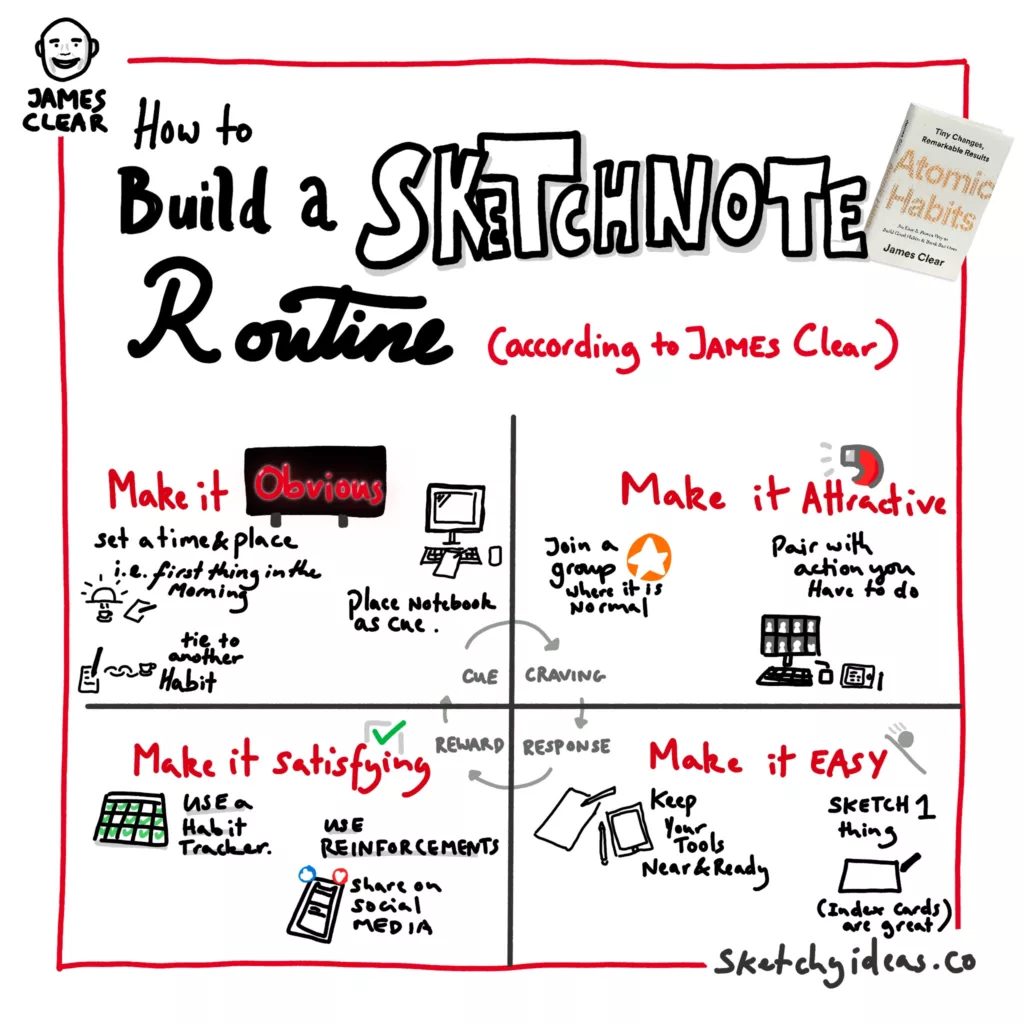(with lessons from the best-selling book on habits, Atomic Habits by James Clear)
Starting a new habit is hard. Even when it’s something you want to do like Sketchnoting.
It’s something James Clear, author of the best-seller Atomic Habits, knows all too well. It’s why he spent almost 10 years researching the best tips for how to create new habits.
In this article, I’ll show you how they can be applied to building a sketchnoting routine.

The four key elements of a habit
Every habit has four stages.
- Cue – the signal that it’s time to do a habit.
- Craving – the desire before you do the habit.
- Response – the action of the habit
- Reward – the positive feeling after you have done the habit.
By understanding each stage you can create and change your habits.
Cue – Make it obvious
Habits don’t happen by chance.
They have triggers. You might not be aware of what triggers your habits, but each one has one. If you want to start a habit, you need a trigger, and it’s best if it’s an obvious one. Here’s a couple of tips:
- Pick a time and place – this makes it easy to know where and when. Make sure it’s a time and place that’s possible e.g., where you have your sketchnote equipment and when you won’t be disturbed.
- Set up your environment to prompt you – this could be an electronic notification on your phone, or putting your sketchnote tools in an obvious place.
- Tie your habit to another habit – if you have an established habit, create a habit chain by adding the new habit you want to it. For example, maybe you could sketchnote when you listen to a podcast on your commute to work by bus.
Craving – Make it attractive
The moment between the trigger and the action is your gut response.
For entrenched habits, there’s a positive anticipation as you await the upcoming reward (more later). This gives you the motivation to do the habit. If there’s no craving, you may choose another action instead.
The way to create the craving is to make the habit as attractive as possible.
One way to achieve this is by joining a group where it is normal. One such group is the Sketchnote Army Slack.
Response – Make it easy
The more effort it takes to do an action, the less likely you are to do it.
This is a great trick for ending a bad habit but it’s vital for starting a good new habit like a sketchnoting routine. Two simple tips are
- Have your tools ready to go
- Set your habit as little sketches, not giant graphic recordings. (based on the 2-minute rule)
These make it far easier to create a sketch every day.
Reward – Make it satisfying
The difference between a habit that sticks and a habit you drop is if it’s immediately satisfying.
Immediately is the key word there. If it has a long-term benefit (like exercising or eating healthily) your mind doesn’t attach the benefit to the action. The sooner you feel the reward, the more you associate it with the action.
A couple of tricks for sketchnotes include
- using a habit tracker to see your progress
- sharing on social media to receive positive feedback on your sketchnotes
- giving yourself a reward that you like afterwards
Ready to build your sketchnoting routine?
If you’ve got this far, I’m guessing you are committed to starting a sketchnote habit (or perhaps a different habit). Here’s what to do next. So take out a piece of paper and write down:
- Pick a time and place for your habit
- Bonus: pair it with another habit you always do
- Work out the minimum sketchnote you can do based on the 2-minute rule. E.g. a sketch on an index card
- Join a community of sketchnoters like the Sketchnote Army Slack
- Get your gear together and put it where you will do your sketches
- Set up a social media account to share your sketchnotes
- Download a habit tracker to reward yourself each time you sketchnote
If you’ve discovered anything that helped you build your sketchnote habit, leave a comment so others can benefit too. I’d love to know!
P.S. If you need help making your first sketchnote, check out this free step-by-step guide.

Leave a Reply